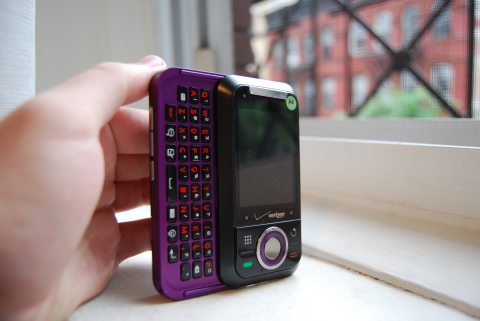Hands-on with the Motorola Rival messaging phone [review]

Earlier today, Motorola announced its Rival mobile messaging phone, which packs a full slide-out QWERTY keyboard, touchscreen elements (I'll get to this later) and visual voicemail, among other things.
The Moto folks were kind enough to let me play with the new device, which I believe is a nice solution for someone who wants a smartphone but doesn't want to pony up the dough for a data plan. The phone offers many features that mimic those on a high-priced smartphone, and to boot, it's a solid handset as well.
[ZDNet Image Gallery: Hands-on with the Motorola Rival messaging phone]
This phone is intended for a more youthful audience that are drawn to constant mobile communication. The device comes in two colors -- silver with red piping, and black with purple piping -- and looks like the kind of phone you'd get your teenager.
Make no mistake, though: this phone is quite capable of serving anyone who doesn't plan on bothering with a true smartphone.
The hardware is very nice. Fit and finish are top-notch, it has a satisfying heft, and the slide out keyboard slips out with a pleasing "sshhh-shk" that even the T-Mobile G1 can't provide. The full QWERTY keyboard has wide, tactile keys, which I find a bit easier to use than the mini-squareish ones on your favorite BlackBerry.
The phone carries a bright, 2.2-in. touchscreen that only activates as a touch input for number dialing and for two bottom buttons, which are indicated by little white lights in each of the screen's corner. In both cases, the phone confirms each touch input with a brief vibration, a bit of tactile feedback I found reasonable. When you slide out the keyboard, the screen adjusts 90 degrees and the "touch" button that becomes out of reach deactivates and another one activates in its place for landscape mode. It's a slick little feature.
However, that brings me to the main hurdle with this phone: because it's a go-between a truly "dumb" phone and a smartphone, it's a little unintuitive. Now that touchscreen smartphones have flooded the market, as users we've become accustomed to their usage tics, such as using "flick" and press gestures. That wreaks havoc here, because the touchscreen only functions in a limited way (dialing and two navigation buttons), and I often had to catch myself from poking at a screen that wasn't designed to respond, particularly when browsing the web.
Which brings us to the user interface. For such a nice piece of hardware, I found the UI to feel a bit "dumb" and only somewhat changed from the Motorola Razr that took the mobile world by storm several years ago. Phones have come a long way since then, and the Rival's hardware proves it. But the software -- particularly when browsing the web, or what have you -- just doesn't feel any newer. The main menu of the device has a stacked, iPhone-like layout, which I found great. But again, I found myself poking the screen instead of using the ring around the big, central confirm button to navigate, and some areas still had the "cramped" feeling of a "dumb" phone.
The phone has several other features, which I detailed in the original announcement: a 2.0 megapixel camera, threaded IM messaging (a nice compromise between true smartphone IM clients and the "dumb" version) and several services in conjunction with Verizon, including GPS navigation/maps, visual voicemail and Rhapsody music playing. The Verizon services cost extra, but nowhere near the price of a smartphone data plan.
So who should buy this phone? In my opinion, everyone who wants a fully-featured phone that isn't a smartphone (with associated costs). It's an incredibly solid-feeling phone with tight gaps between exterior panels and a good tactile feeling. The only drawback is that the UI takes a little getting used to if you've ever used an iPod touch or similar device.
At $99 with a two-year contract, I was initially going to say that the Rival is a good value for the price -- you're on what is considered the best carrier in the country, and the phone is impressive with regard to fit and finish. It's much cheaper than the latest T-Mobile Sidekick ($229) and most smartphones out there, which hover around $200.
I showed it to a friend who has an LG Venus -- similar both in size and features, also on Verizon -- and she felt inclined to make the switch for the Rival's QWERTY keyboard. That's a good sign.
But the market changes fast, and just this week Apple dropped the price of its iPhone 3G to $99 on AT&T. It's clear that puts pressure on true smartphone competition such as the T-Mobile G1, Palm Pre, RIM BlackBerry and others, but it also puts pressure on this segment of the mobile market to justify their prices for phones that can't do quite as much.
A $99 price tag for the Rival was a great deal last week. Thanks to Apple's recent waves, it's a tougher sell. Despite this concern, I recommend the Motorola Rival.
